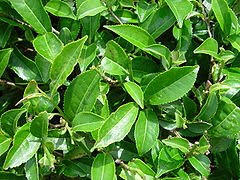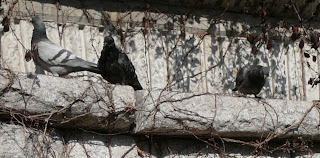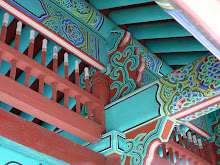We were also intrigued by the coffee and tea sections on the first floor. I had been looking for something-other-than-Lipton black tea since we arrived, and the local market only sells a variety of green teas and some fruit teas, all of which are sold by the bag (or jar) en mass. I set out to find a familiar box of Earl Grey. (I'm okay with bags, but they shouldn't be Lipton.)
 I'm beginning to sound a bit snooty about tea. I should clarify that I don't really know bunk about tea other than the fact that I like to drink Earl Grey with a bit of honey and milk. I've preferred this to coffee for some years and here in Seoul I was missing both dark tea and dark coffee. I found the tea displays and looked longingly at signs I didn't understand for about twenty seconds before two women approached to help me.
I'm beginning to sound a bit snooty about tea. I should clarify that I don't really know bunk about tea other than the fact that I like to drink Earl Grey with a bit of honey and milk. I've preferred this to coffee for some years and here in Seoul I was missing both dark tea and dark coffee. I found the tea displays and looked longingly at signs I didn't understand for about twenty seconds before two women approached to help me.Department stores seem to hire hoards of people to sell their goods. In every corner of every department, a uniformed woman waits to assist you in any way she can. From a western perspective this can be overwhelming to the point of annoying, because there is a sense of pressure to buy when an employee follows your every move. On the other hand, if you are looking for information or even to buy a product, a friendly assistant is no more than two feet away. (I've quickly come to accept this cultural difference, even though it takes some level of mind over body to remember the woman following me isn't assuming I'm a thief, nor is she trying to pressure me into buying and leaving her store. Minimum wage is about 4,000 won--or $3--in Korea and jobs at all levels are competitive. The attentive service brings job security to an employee, if not additional commission.)
The women helped me choose a Korean tea--one not stored in teabags, but rather in caps of tightly pressed dried tealeaves wrapped in tissue paper. Each cap brews 2 liters of tea. This tea is fermented, they told me (like so much else in Korea, I thought happily), and has purifying qualities for good health. I was trying something new! But I also included a box of familiar Earl Grey tea in my final order.
At home I brewed my fermented tea and drank it. A lovely tea indeed; my unsophisticated pallet believing it to be much like a black tea. I couldn't tell you what was fermented about this tea. I'm not sure what I had expected, but I found it not unusual in the least. I welcomed a break from the green tea that is as lovely, but somehow slightly tiresome in its unfamiliarity. In the west we hear so much about green tea and its antioxidants, its purifying nature. It's the best tea, the healthiest, and the trendiest, too. This has always made me feel a bit bad about preferring black tea. Could I really be doing my body so badly? Alas, it makes no difference as I now had fermented tea, which purifies AND tastes like what I want to drink.
Fast forward several weeks and I am introduced to tea from a different perspective, a Korean perspective.
 She continued: "Green tea, white tea, Oolong tea, black tea, they all come from the same plant. The difference between these teas is the level of fermentation the leaves are exposed to. Green tea is not fermented at all and, therefore, maintains high levels of vitamin C. Fermented teas lose much of their vitamin C in the process, but maintain their purifying qualities."
She continued: "Green tea, white tea, Oolong tea, black tea, they all come from the same plant. The difference between these teas is the level of fermentation the leaves are exposed to. Green tea is not fermented at all and, therefore, maintains high levels of vitamin C. Fermented teas lose much of their vitamin C in the process, but maintain their purifying qualities."This information was so new for me that I had to research it online when I got home. Indeed, green tea and black tea are one in the same and the term fermentation is quite misleading as tea leaves are not treated with vinegar and left to steep for weeks or months, but rather oxidized. Alas, the Camellia sinensis made my evening. My fermented tea is black tea and it is no less beneficial to my body than green tea (so long as I find enough vitamin C elsewhere).
The most rewarding event of the evening (outside of drinking lovely teas, of course) was peering into the tea-maker's large ceramic bowl of lotus tea. This was an infused green tea and I'll tell you, when it is done right, green tea is not tiresome.






